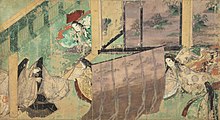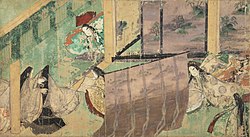
Back فترة هييآن Arabic Periodu Heian AST Heyan dövrü Azerbaijani Хеян Bulgarian হেইআন যুগ Bengali/Bangla Marevezh Heian Breton Període Heian Catalan Období Heian Czech Heian-Zeit German Περίοδος Χεϊάν Greek
You can help expand this article with text translated from the corresponding article in Japanese. Click [show] for important translation instructions.
|
| Heian period | |||
|---|---|---|---|
| 794–1185 | |||
 An illustrated scroll of the Tale of Genji by the 11th century writer Murasaki Shikibu | |||
| Location | Japan | ||
| Key events |
| ||
Chronology
| |||
| Part of a series on the |
| History of Japan |
|---|
 |
The Heian period (平安時代, Heian jidai) is the last division of classical Japanese history, running from 794 to 1185.[1] It followed the Nara period, beginning when the 50th emperor, Emperor Kammu, moved the capital of Japan to Heian-kyō (modern Kyoto). Heian (平安) means 'peace' in Japanese. It is a period in Japanese history when the Chinese influences were in decline and the national culture matured. The Heian period is also considered the peak of the Japanese imperial court, noted for its art, especially poetry and literature. Two syllabaries unique to Japan, katakana and hiragana, emerged during this time. This gave rise to Japan's famous vernacular literature, with many of its texts written by court women who were not as educated in Chinese as their male counterparts.

Although the Imperial House of Japan had power on the surface, the real power was in the hands of the Fujiwara clan, a powerful aristocratic family who had intermarried with the imperial family. Many emperors had mothers from the Fujiwara family.[2] The economy mostly existed through barter and trade, while the shōen system enabled the accumulation of wealth by an aristocratic elite. Even though the Heian period was one of national peace, the government failed to effectively police the territory, leading to frequent robberies of travellers.